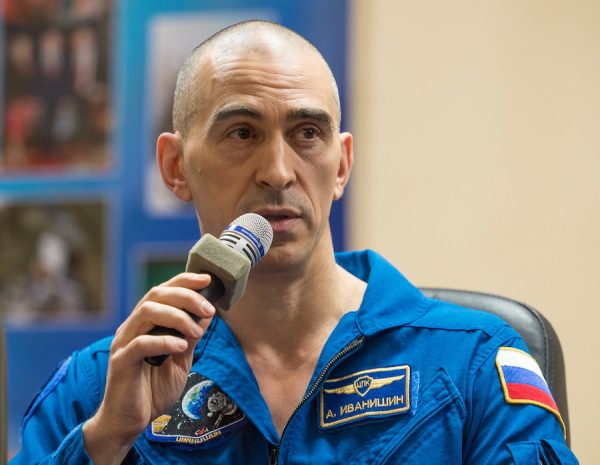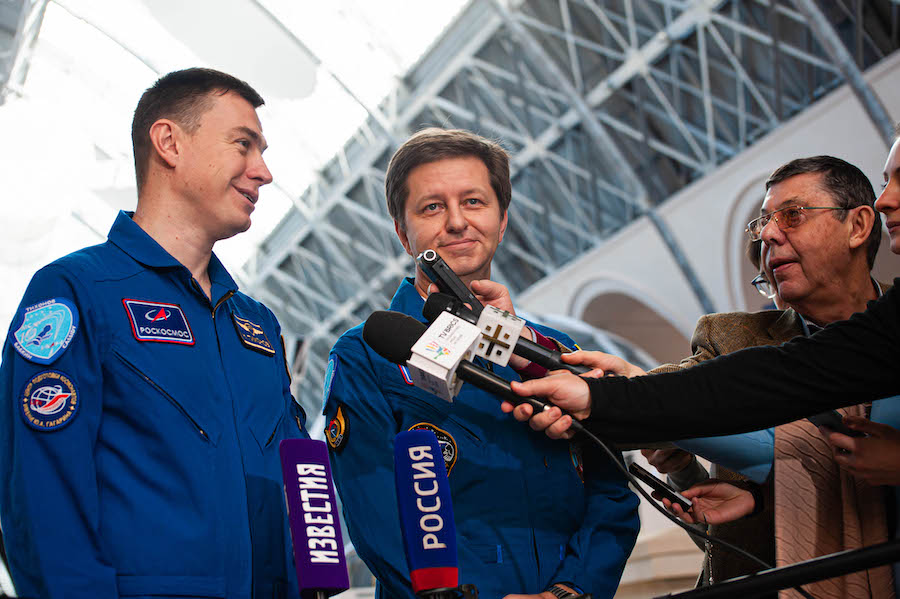Russian space agency replaces cosmonauts on next space station crew – Spaceflight Now

Citing medical reasons, Russia’s space agency announced Wednesday that it is replacing two cosmonauts who were scheduled to fly on the next Soyuz mission to the International Space Station in April with backup crew members.
Russian cosmonauts Nikolai Tikhonov and Andrei Babkin were training for launch April 9 from the Baikonur Cosmodrome with NASA astronaut Chris Cassidy on the Soyuz MS-16 spacecraft.
Roscosmos, the Russian space agency, said Wednesday Tikhonov and Babkin — both rookie cosmonauts — will be replaced by cosmonauts Anatoly Ivanishin and Ivan Vagner on the Soyuz MS-16 mission. Cassidy’s assignment to the mission remains unchanged.
In a statement, Roscosmos said it is changing the crew assignment due to “medical reasons.” Russian news reports said Tikhonov injured his eye, and Roscosmos elected to swap both promote both backup Russian crew members to the prime Soyuz MS-16 crew.
Ivanishin, 51, is a veteran cosmonaut who has completed two expeditions on the International Space Station, logging more than 280 days in space on missions that launched in 2011 and 2016. Before his selection as a cosmonaut, Ivanishin was a combat pilot who flew MiG-29 and Su-27 fighter jets in the Russian Air Force. He will serve as commander of the Soyuz MS-16 spacecraft.
Vagner, 34, will fly as board engineer on the Soyuz MS-16 spaceship. He is assigned to fly on his first mission into space.

Russian station commander Oleg Skripochka and NASA crewmates Drew Morgan and Jessica Meir will welcome the Soyuz MS-16 crew to the station in April for a week-long crew handover period. Then Skripochka’s Expedition 62 crew will depart and head for landing in Kazakhstan on the Soyuz MS-15 spacecraft, leaving Ivanishin, Vagner and Cassidy behind as a three-person crew.
Cassidy will take over as space station commander from Sripochka, and his Expedition 63 crew will have the station to themselves until the planned launch and docking of SpaceX’s first piloted Crew Dragon mission with NASA astronauts Doug Hurley and Bob Behnken on-board.
The Crew Dragon’s first piloted test flight is currently scheduled to lift off some time in May. NASA has not decided on the duration of Hurley and Behnken’s mission, but the astronauts could remain on the station for weeks or months, becoming part of the Expedition 63 crew.
If SpaceX encounters delays, the space station will remain staffed with a crew of three — down from the standard crew size of six — until the Crew Dragon arrives, or until the launch of the next Soyuz crew in October. The possibility of an extended period with three residents on the station — and just one U.S. astronaut — prompted managers to train the original Soyuz MS-16 crew on systems inside the U.S. segment of the outpost.
Tikhonov trained to use NASA’s spacesuits in case he needed to join Cassidy on a spacewalk performing repairs or maintenance outside the space station. And Babkin was certified to operate the station’s Canadian-built robotic arm.
Megan Sumner, a NASA spokesperson, said Wednesday that Ivanishin and Vagner will not travel to the Johnson Space Center in Houston for additional training before their April 9 launch. Cassidy will head to Russia later this month to join his new Russian crewmates for final training and familiarization with the Soyuz spacecraft, before heading to the Baikonur Cosmodrome in late March for launch preparations.
Cassidy was previously a crewmate of Ivanishin and Vagner on the Soyuz MS-16 backup crew before he was elevated to the prime crew last year to replace a Japanese astronaut. During that time, Sumner said Cassidy conducted U.S. spacesuit and spacewalk training with Ivanishin, including training inside NASA’s Neutral Buoyancy Laboratory at the Johnson Space Center in Houston.
Along with Boeing’s Starliner capsule, the Crew Dragon is one of two new U.S. human-rated spaceships in the final stages of development. SpaceX’s capsule is expected to fly with a crew first, becoming the first vehicle to carry astronauts into orbit from U.S. soil since the retirement of the space shuttle in 2011.
Since 2011, U.S. astronauts have flown on Russian Soyuz spacecraft to and from the space station with tickets paid by the U.S. government. NASA paid more than $80 million per seat to Roscosmos, an entity of the Russian government, the last time it purchased Soyuz seats.
With the beginning of regular crew rotation service by the new SpaceX and Boeing spaceships, NASA will end its sole reliance on Russian Soyuz crew capsules. But U.S. astronauts will continue flying on Soyuz missions, and Russian cosmonauts will regularly launch and land on Crew Dragon and Starliner spacecraft through a barter agreement between NASA and Roscosmos that does not include any exchange of funds.
Email the author.
Follow Stephen Clark on Twitter: @StephenClark1.






